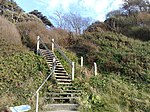Headon Warren and West High Down SSSI
Sites of Special Scientific Interest on the Isle of Wight

Headon Warren and West High Down is a 276.3-hectare (683-acre) Site of Special Scientific Interest (SSSI) located at the westernmost end of the Isle of Wight. The SSSI encompasses Headon Warren, a heather clad down to the north, the chalk downs of West High Down and Tennyson Down to the south, and the Needles, The Needles Batteries and Alum Bay to the west.The site was notified in 1951 by the Nature Conservancy Council (NCC), for both its biological and geological features, and that designation is now maintained by Natural England as successor body to the NCC. Most of the land within the SSSI is owned and managed by the National Trust.
Excerpt from the Wikipedia article Headon Warren and West High Down SSSI (License: CC BY-SA 3.0, Authors, Images).Headon Warren and West High Down SSSI
Alum Bay New Road,
Geographical coordinates (GPS) Address Nearby Places Show on map
Geographical coordinates (GPS)
| Latitude | Longitude |
|---|---|
| N 50.666 ° | E -1.563 ° |
Address
Alum Bay New Road
PO39 0JD
England, United Kingdom
Open on Google Maps










